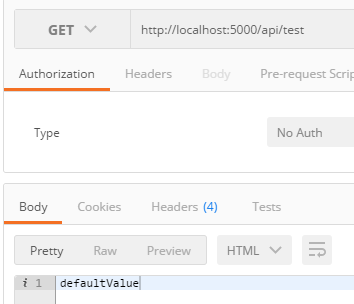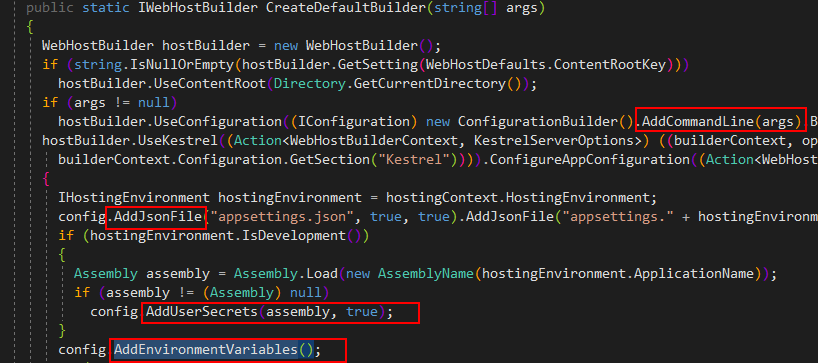ASP.NET Core 2.2 基础知识(六) 配置(内含MySql+EF)
先上一段代码,了解一下 .NET Core 配置数据的结构.
新建一个 控制台项目,添加一个文件 json.json ,文件内容如下:
{
"country": "cn",
"person": {
"id": 1,
"address": {
"addName": "chengdu"
}
}
}
控制台代码:
private static void Main(string[] args)
{
ConfigurationBuilder builder = new ConfigurationBuilder();
builder.AddJsonFile(path: @"E:\xxx\my\core\VS2017\MyConfig\Demo2\json.json", optional: false, reloadOnChange: true);
IConfigurationRoot config = builder.Build();
Console.WriteLine(config["country"]);//cn
Console.WriteLine(config["person:id"]);//
Console.WriteLine(config["person:address:addname"]);//chengdu
Console.ReadKey();//修改 json.json 文件中 "id":2
Console.WriteLine(config["person:id"]);//2
Console.ReadKey();
}
AddJsonFile 方法有多个重载,上面只给出了其中一个,3个参数分别表示:
path:文件的物理路径;
optional: xml 文档是这样写的:Whether the file is optional. 该文件是否可选.true 表示可选,即如果该文件不存在,不会抛出异常,下面的所有显示都为空;false 表示不可选,即如果该文件不存在,会抛出异常.
reloadOnChange:如果文件修改了,是否重新加载.
配置提供程序
ASP.NET Core 常用的共有6种配置提供程序 :
- 命令行配置提供程序
- 环境变量配置提供程序
- 文件配置提供程序
- Key-per-file配置提供程序
- 内存配置提供程序
- 自定义配置提供程序
一.命令行配置提供程序 : AddCommandLine
1.新建一个 WebAPI 项目,新建一个 TestController
[Route("api/[controller]")]
[ApiController]
public class TestController : ControllerBase
{
private readonly IConfiguration _config;
public TestController(IConfiguration configuration)
{
_config = configuration;
}
public string Get()
{
//读取配置数据中 Key 为 CommandLineKey 的值,如果没有这个 Key,则返回默认值: defaultValue
//读取配置文件的方法后面会单独讲.
return _config.GetValue("CommandLineKey","defaultValue");
}
}
2.修改 CreateWebHostBuilder 方法
public class Program
{
public static void Main(string[] args)
{
CreateWebHostBuilder(args).Build().Run();
} public static IWebHostBuilder CreateWebHostBuilder(string[] args)
{
var config = new ConfigurationBuilder().AddCommandLine(args).Build();
var hostBuilder = WebHost.CreateDefaultBuilder(args);
return hostBuilder.UseConfiguration(config).UseStartup<Startup>();
}
}
3.测试:
1)不传参数


2)传入参数


传参的格式有多种:
dotnet run CommandLineKey1=Value1
dotnet run --CommandLineKey2=Value2
dotnet run --CommandLineKey3 Value3
dotnet run /CommandLineKey4=Value4
dotnet run /CommandLineKey5 Value5
此外,传入的以单横杠"-"或者双横杠"--"作为前缀的 Key 支持替换:
public class Program
{
public static void Main(string[] args)
{
CreateWebHostBuilder(args).Build().Run();
} public static IWebHostBuilder CreateWebHostBuilder(string[] args)
{
Dictionary<string, string> switchMapping = new Dictionary<string, string>
{
{"-key", "CommandLineKey"},
{"--key", "CommandLineKey"},
}; IConfigurationRoot config = new ConfigurationBuilder().AddCommandLine(args, switchMapping).Build();
return WebHost.CreateDefaultBuilder().UseConfiguration(config).UseStartup<Startup>();
}
}
测试图:


两种情况都会显示

实际上,在 2.X 版本,CreateDefaultBuilder(args) 方法内部已经调用了 AddCommandLine(args) 方法,我们不需要再调一次了.源码(部分)如下:

二.环境变量配置提供程序 : AddEnvironmentVariables
在 2.X 版本,CreateDefaultBuilder(args) 方法内部已经调用了 AddEnvironmentVariables() 方法,我们不需要再调一次了.源码(部分)如下:

其实,红框框起来的方法都是配置提供程序.
那么,环境变量到底有哪些呢?哪里可以看呢?
新建如下控制器:
[Route("api/[controller]/[action]")]
[ApiController]
public class TestController : ControllerBase
{
private readonly IConfiguration _config;
public TestController(IConfiguration configuration)
{
_config = configuration;
}
public IEnumerable<KeyValuePair<string, string>> GetAll()
{
return _config.AsEnumerable();
}
public string Get(string key)
{
return _config.GetValue(key, "defaultValue");
}
}
太多了,只截了其中一小部分:

我们试试查询红框标注的环境变量:

三.文件配置提供程序 : AddJsonFile , AddIniFile , AddXmlFile
以 AddJsonFile 为例讲解,其他两个都差不多.
从上面的源码截图中我们已经看到,在使用 CreateDefaultBuilder 方法初始化新的 WebHostBuilder 时,会自动调用 AddJsonFile 两次,依次从下面两个文件加载配置:
appsettings.json : 首先读取该文件.
appsettings.{Environment}.json : 再读取此文件,该文件中的配置会替代 appsettings.json 文件中的值.
示例: (红色部分是自己加的)
appsettings.json:
{
"Logging": {
"LogLevel": {
"Default": "Warning"
}
},
"AllowedHosts": "*",
"FirstSection": {
"SecondSection": "hello world"
}
}
appsettings.{Environment}.json:
{
"Logging": {
"LogLevel": {
"Default": "Debug",
"System": "Information",
"Microsoft": "Information"
}
},
"FirstSection": {
"SecondSection": "fuck u"
}
}
请求结果:

下面我们来创建自己的配置文件:
在当前项目下新建一个 jsonconfig.json 文件:
{
"id": ,
"name": "wjire"
}
CreateWebHostBuilder 方法修改如下:
public static IWebHostBuilder CreateWebHostBuilder(string[] args)
{
IWebHostBuilder hostBuilder = WebHost.CreateDefaultBuilder(args);
return hostBuilder.ConfigureAppConfiguration((context, builder) =>
{
builder.AddJsonFile(Path.Combine(context.HostingEnvironment.ContentRootPath, "jsonconfig.json"),
true, true);
}).UseStartup<Startup>();
}
图就不上了...
附:
AddIniFile 配置文件:
[section0]
key0=value
key1=value
[section1]
subsection:key=value
[section2:subsection0]
key=value
[section2:subsection1]
key=value
AddXmlFile 配置文件
<?xml version="1.0" encoding="UTF-8"?>
<configuration>
<section0>
<key0>value</key0>
<key1>value</key1>
</section0>
<section1>
<key0>value</key0>
<key1>value</key1>
</section1>
</configuration>
四.Key-per-file 配置提供程序 AddKeyPerFile
这个提供程序有点特别,它是将文件名(含扩展名)作为 Key,文件内容作为 Value.
示例:
在当前项目下新建一个 filename.txt 文件,文件内容就一句话: hello world
public static IWebHostBuilder CreateWebHostBuilder(string[] args)
{
IWebHostBuilder hostBuilder = WebHost.CreateDefaultBuilder(args);
return hostBuilder.ConfigureAppConfiguration((context, builder) =>
{
//param1:文件所在目录的物理路径
//param2:该文件是否可选
builder.AddKeyPerFile(context.HostingEnvironment.ContentRootPath, true);
}).UseStartup<Startup>();
}
控制器如下:
[Route("api/[controller]/[action]")]
[ApiController]
public class TestController : ControllerBase
{
private readonly IConfiguration _config;
public TestController(IConfiguration configuration)
{
_config = configuration;
}
public string Get(string key)
{
return _config.GetValue(key, "defaultValue");
}
}

五. 内存配置提供程序 AddInMemoryCollection
这个很简单,直接上图:
public static IWebHostBuilder CreateWebHostBuilder(string[] args)
{
Dictionary<string, string> memoryCollection = new Dictionary<string, string>
{
{"id","" },
{"name","wjire" }
};
IWebHostBuilder hostBuilder = WebHost.CreateDefaultBuilder(args);
return hostBuilder.ConfigureAppConfiguration((context, builder) =>
{
builder.AddInMemoryCollection(memoryCollection);
}).UseStartup<Startup>();
}

六.自定义配置提供程序
该示例演示了如果使用EF创建从数据库(MySql)读取配置的提供程序.
第一步:安装 MySqlEF

第二步:创建数据库表:
CREATE TABLE `myconfigs` (
`Id` varchar() NOT NULL DEFAULT '',
`value` varchar() NOT NULL DEFAULT '',
PRIMARY KEY (`Id`)
) ENGINE=InnoDB DEFAULT CHARSET=utf8;
第三步:创建实体类
public class MyConfig
{
public string Id { get; set; } public string Value { get; set; }
}
第四步:创建数据库上下文
public class MyConfigContext : DbContext
{
public MyConfigContext(DbContextOptions<MyConfigContext> options) : base(options)
{
} public DbSet<MyConfig> MyConfigs { get; set; }
}
第五步:创建配置数据源
public class MyConfigSource : IConfigurationSource
{
private readonly Action<DbContextOptionsBuilder> _optionsAction; public MyConfigSource(Action<DbContextOptionsBuilder> optionsAction)
{
_optionsAction = optionsAction;
} public IConfigurationProvider Build(IConfigurationBuilder builder)
{
return new MyConfigProvider(_optionsAction);
}
}
第六步:创建配置数据源提供器
public class MyConfigProvider : ConfigurationProvider
{
private Action<DbContextOptionsBuilder> OptionsAction { get; } public MyConfigProvider(Action<DbContextOptionsBuilder> optionsAction)
{
OptionsAction = optionsAction;
} //从数据库读取配置
public override void Load()
{
DbContextOptionsBuilder<MyConfigContext> builder = new DbContextOptionsBuilder<MyConfigContext>();
OptionsAction(builder);
using (MyConfigContext dbContext = new MyConfigContext(builder.Options))
{
//Data 是基类 ConfigurationProvider 的属性,用来存储配置数据源的.
Data = !dbContext.MyConfigs.Any()//判断表是否有数据
? CreateAndSaveDefaultValues(dbContext)//如果没有数据,则添加一些数据,存储到配置数据源中.
: dbContext.MyConfigs.ToDictionary(c => c.Id, c => c.Value);//如果有数据,读取出来,存储到配置数据源中.
}
} private static IDictionary<string, string> CreateAndSaveDefaultValues(MyConfigContext dbContext)
{
Dictionary<string, string> configValues = new Dictionary<string, string>
{
{ "", "refuge" },
{ "", "" },
{ "", "chengdu" }
};
dbContext.MyConfigs.AddRange(configValues.Select(kvp => new MyConfig
{
Id = kvp.Key,
Value = kvp.Value
}).ToArray());
dbContext.SaveChanges();
return configValues;
}
}
第七步:创建扩展方法,对外公开自定义的数据提供程序
public static class MyConfigExtension
{
public static IConfigurationBuilder AddCustomConfigurationProviderApp(this IConfigurationBuilder builder, Action<DbContextOptionsBuilder> optionsAction)
{
return builder.Add(new MyConfigSource(optionsAction));
}
}
第八步:创建测试用的控制器
[Route("api/[controller]/[action]")]
[ApiController]
public class TestController : ControllerBase
{
private readonly IConfiguration _config;
public TestController(IConfiguration configuration)
{
_config = configuration;
}
//查询所有
public IEnumerable<KeyValuePair<string, string>> GetAll()
{
return _config.AsEnumerable();
}
//查询某个key
public string Get(string key)
{
return _config.GetValue(key, "defaultValue");
}
}
第九步:调用自定义配置提供程序
public class Program
{
public static void Main(string[] args)
{
CreateWebHostBuilder(args).Build().Run();
} public static IWebHostBuilder CreateWebHostBuilder(string[] args)
{ IWebHostBuilder hostBuilder = WebHost.CreateDefaultBuilder(args);
return hostBuilder.ConfigureAppConfiguration((context, builder) =>
{
builder.AddCustomConfigurationProviderApp(options => options.UseMySql("Server=localhost;Database=test;User=root"));
}).UseStartup<Startup>();
}
}
测试结果:
1)查询所有,可以看到,我们新增的配置数据已经加到系统中了;(看右边的滚动条就知道总共有很多很多配置...)

2)查询特定key

如果使用该方式提供配置数据,需要注意以下两点:
1.提供程序在启动时就将数据库表读入配置,不会基于每个key查询数据库;
2.应用启动后,更新数据库,配置不会更新.
上面讲了如果提供配置数据,下面讲获取配置的几种常用方法:
一.GetValue 上面已经演示过了,这里不再重复.只把常用的重载方法列出来
GetValue<T>("key") 如果 key 不存在,则会抛异常;
GetValue<T>("key",T default) 如果 key 不存在,则返回默认值
二. T Get<T>()
对于下面这个 json 文件:
{
"name": "refuge",
"age": ,
"address": {
"city": "chengdu"
}
}
定义一个实体:
public class Person
{
public string Name { get; set; } public int Age { get; set; } public Address Address { get; set; }
} public class Address
{
public string City { get; set; }
}
控制器:
[Route("api/[controller]/[action]")]
[ApiController]
public class TestController : ControllerBase
{
private readonly IConfiguration _config;
public TestController(IConfiguration configuration)
{
_config = configuration;
}
public string Get()
{
var person = _config.Get<Person>();
return JsonConvert.SerializeObject(person);
}
}
调用结果:

但是这种方式,个人持反对态度,因为存储在系统中的配置数据有很多很多,上述方法相当于读取所有配置数据来反序列化.
三.GetSection
讲该方法之前,有必要再熟悉一下配置在系统中的存储结构到底是怎么样的.
对于上面那个 json 文件:name": "refuge",
"age": 36,
"address": {
"city": "chengdu"
}
}
将其读入配置后,存储的结构如下:
{"key":"name","value":"refuge"}
{"key":"age","value":"36"}
{"key":"address","value":null} //通过查询所有配置,确实有这一行,这意味着想通过 GetValue<string>("address") 反序列化为对象是不可能的...
{"key":"address:city","value":"chengdu"}]
对于上面这些配置,"refuge" 和 "36" 是可以通过第一个方法 GetValue<string>("name") , GetValue<string>("age") 来获取.

而 "chengdu" 只能用 GetValue<string>("address:city") 方法获取了.

因此,要通过该方法把上述json文件的内容转成 Person 对象,则需要对 json 文件进行修改,添加一个 "person" 节点:
{
"person": {
"name": "refuge",
"age": ,
"address": {
"city": "chengdu"
}
}
}
Action:
public string Get()
{
//方法一:
{
Person person = _config.GetSection("person").Get<Person>();
return JsonConvert.SerializeObject(person);
} //方法二:
{
//Person person = new Person();
//_config.GetSection("person").Bind(person);
//return JsonConvert.SerializeObject(person);
}
}
方法一明显要帅气得多!
问题又来了,如果我只想反序列化 "address" 节点的值,怎么办呢?下面这个方法可以完成.
四.GetChildren
Action:
public string Get()
{
IConfigurationSection firstChildSection = _config.GetSection("person").GetChildren().First();
Address address = firstChildSection.Get<Address>();
return JsonConvert.SerializeObject(address);
}

貌似完了.
2019年1月6日补充:
上面提到的全是从当前项目加载配置,ASP.NET Core 2.0 提供了从外部程序集加载配置的方法
需要实现该接口:
public interface IHostingStartup
{
void Configure(IWebHostBuilder builder);
}
示例:
新建类库 : ExternalAssembly
namespace ExternalAssembly
{
public class ExternalConfig : IHostingStartup
{
public void Configure(IWebHostBuilder builder)
{
Dictionary<string, string> memoryCollection = new Dictionary<string, string>
{
{"id","" },
{"name","refuge"}
};
builder.ConfigureAppConfiguration((context, configBuilder) =>
{
configBuilder.AddInMemoryCollection(memoryCollection);
});
}
}
}
这里要特别注意:
ConfigureAppConfiguration 方法需要安装nuget包:
创建一个 WebAPI 项目,添加对上述类库的引用,并在 Program 类中添加对该类库的调用声明(红色标注):
using Microsoft.AspNetCore;
using Microsoft.AspNetCore.Hosting; [assembly: HostingStartup(typeof(ExternalAssembly.ExternalConfig))] namespace Demo5
{
public class Program
{
public static void Main(string[] args)
{
CreateWebHostBuilder(args).Build().Run();
} public static IWebHostBuilder CreateWebHostBuilder(string[] args)
{
return WebHost.CreateDefaultBuilder(args).UseStartup<Startup>();
}
}
}
图就不上了.
ASP.NET Core 2.2 基础知识(六) 配置(内含MySql+EF)的更多相关文章
- [ASP.NET Core开发实战]基础篇06 配置
配置,是应用程序很重要的组成部分,常常用于提供信息,像第三方应用登录钥匙.上传格式与大小限制等等. ASP.NET Core提供一系列配置提供程序读取配置文件或配置项信息. ASP.NET Core项 ...
- ASP.NET Core 2.2 基础知识(十六) SignalR 概述
我一直觉得学习的最好方法就是先让程序能够正常运行,才去学习他的原理,剖析他的细节. 就好像这个图: 所以,我们先跟着官方文档,创建一个 SignalR 应用: https://docs.microso ...
- ASP.NET Core 2.2 基础知识(十八) 托管和部署 概述
为了方便演示,以 .NET Core 控制台应用程序讲解. 我们新建一个控制台应用程序,安装 "Newtonsoft.Json" Nuget 包,然后右键点击该项目,选择" ...
- ASP.NET Core 2.2 基础知识(十二) 发送 HTTP 请求
可以注册 IHttpClientFactory 并将其用于配置和创建应用中的 HttpClient 实例. 这能带来以下好处: 提供一个中心位置,用于命名和配置逻辑 HttpClient 实例. 例如 ...
- ASP.NET Core 2.2 基础知识(十四) WebAPI Action返回类型(未完待续)
要啥自行车,直接看手表 //返回基元类型 public string Get() { return "hello world"; } //返回复杂类型 public Person ...
- ASP.NET Core 2.2 基础知识(十三) WebAPI 概述
我们先创建一个 WebAPI 项目,看看官方给的模板到底有哪些东西 官方给出的模板: [Route("api/[controller]")] [ApiController] pub ...
- ASP.NET Core 2.2 基础知识(十一) ASP.NET Core 模块
ASP.NET Core 应用与进程内的 HTTP 服务器实现一起运行.该服务器实现侦听 HTTP 请求,并在一系列请求功能被写到 HttpContext 时,将这些请求展现到应用中. ASP.NET ...
- ASP.NET Core 2.2 基础知识(十) Web服务器 - Kestrel
ASP.NET Core 应用与进程内的 HTTP 服务器实现一起运行.该服务器实现侦听 HTTP 请求,并在一系列请求功能被写到 HttpContext 时,将这些请求展现到应用中. ASP.NET ...
- ASP.NET Core 2.2 基础知识(九) 使用托管服务实现后台任务
在 ASP.NET Core 中,后台任务作为托管服务实现.托管服务是一个类,而且必须实现 IHostedService 接口,该接口定义了两个方法: StartAsync(CancellationT ...
随机推荐
- SQL语言:结构化查询语言
SQL语言:结构化查询语言 程序员或者DBA(数据库管理员)使用SQL和DBBSM进行交互,操纵数据库中的资源 分类: 1.DDL 数据定义语言 结构 create 创建 database ta ...
- wmic的用法
原始文章链接:http://blog.sina.com.cn/s/blog_5fb265c70100w4d0.html 一.wmic的基本命令格式简析 经常看网上的相关资料的话,读者可能会对wmic有 ...
- Ubuntu下安装LNMP之nginx的安装
Nginx 最初是作为一个 Web 服务器创建的,用于解决 C10k 的问题.作为一个 Web 服务器,它可以以惊人的速度为您的数据服务.但 Nginx 不仅仅是一个 Web 服务器,你还可以将其用作 ...
- python3初识selenium
第一步:安装与配置 1.电脑上需要有火狐浏览器(默认安装在C:\Program Files (x86)\Mozilla Firefox目录下). 2.使用pip install selenium安装好 ...
- POJ3189:Steady Cow Assignment(二分+二分图多重匹配)
Steady Cow Assignment Time Limit: 1000MS Memory Limit: 65536K Total Submissions: 7482 Accepted: ...
- Hbase写入量大导致region过大无法split问题
最近在线上往hbase导数据,因为hbase写入能力比较强,没有太在意写的问题.让业务方进行历史数据的导入操作,中间发现一个问题,写入速度太快,并且业务数据集中到其中一个region,这个region ...
- ES6学习笔记(四)—— async 函数
await 是 async wait 的简写, 是 generator 函数的语法糖. async 函数的特点: async 声明一个方法是异步的,await 则等待这个异步方法执行的完成 async ...
- 复选框 checkbox 选中事件
项目中用的jquery-1.11 今天需要检测一个checkbox的选中状态,想当然的用 .attr("checked") ,结果发现,无论是否选中,这个值都是 undefined ...
- WEB-INF 有关的目录路径问题总结
1.资源文件只能放在WebContent下面,如 CSS,JS,image等.放在WEB-INF下引用不了. 2.页面放在WEB-INF目录下面,这样可以限制访问,提高安全性.如JSP,html 3. ...
- centos 下构建lamp环境
构建准备: 1.配置防火墙,开启80端口.3306端口 vi /etc/sysconfig/iptables -A INPUT -m state --state NEW -m tcp -p tcp - ...

